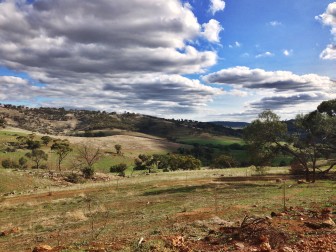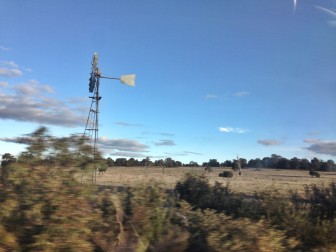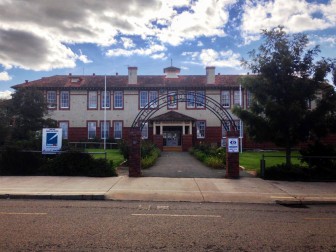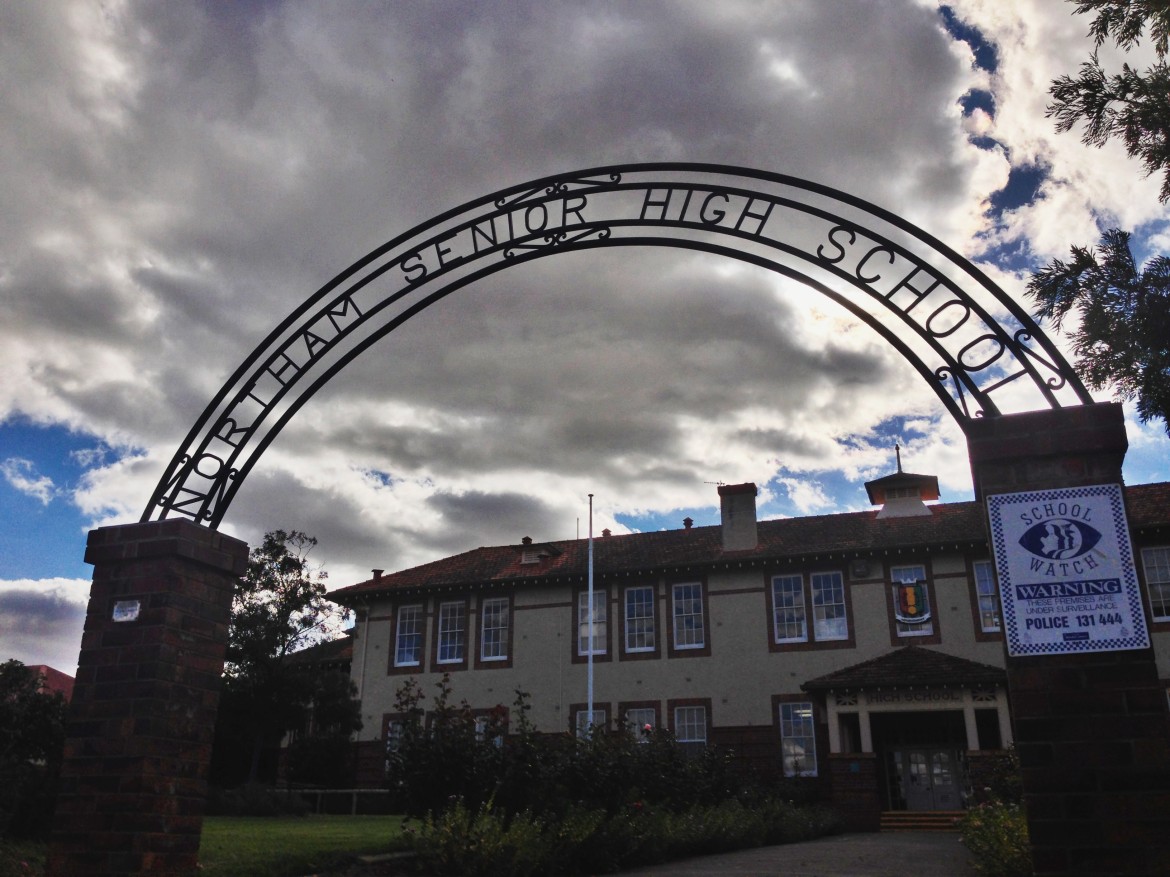
Savannah Thatcher / JJIE
Northam High School in Northam, Australia.
NORTHAM, Australia -- Sometimes on a Friday night, when there’s nothing better to do and the streets are quiet, indigenous kids in this town 100km (some 60 miles) north-east of Perth, Western Australia, might hang out at the local police station.
They’re often not there by choice, but they don’t really mind sticking around either. They get to watch TV, they could get a hot meal. An officer sits and watches them, sometimes all night. It helps the kids, but it means he can't respond to any other calls for help. It’s a small town of nearly 7,000, and at night there are usually only one or two police on duty.
The trouble often starts when the kids wander around town, causing problems here and there. In a small community with little entertainment on offer, causing trouble seems an appropriate cure for boredom. And then the cops pick them up.
“We’re having to sit and look after kids at nighttime because we’ve got nowhere to take them. It’s not really a policing role but if we didn’t do that, what would happen to that child? What would they do? Where would they go?” says Sgt. David Flaherty.
In a different world they'd go home to their parents, because police have better things to do than babysit. But these children live in homes where it might not be safe to return.
Sen-Sgt. Mal Ward is in charge of this small, understaffed station in outback Western Australia.
“We have a large, significant problem with juveniles walking the streets … but when we take them home we have to be very careful of what we’re delivering them to,” Sen-Sgt. Ward says.
Sgt. Flaherty agrees. “The crux of a lot of our juvenile problems is the home life.
“The vast majority of youth offenders … [it] comes back to their upbringing. Comes back to the parenting. Like Sgt. Ward said, the environment they’re going back to, the environment they have to live in - most kids don’t want to be there. We’re sort of having to take on a parenting role, in some respects.”
Such an unconventional arrangement is unusual; children here are, in some ways, being taught right from wrong, not by their parents but by those empowered to imprison them. It’s a radical approach to a problem hurting indigenous communities across Australia, where family breakdown and entrenched cultural and social issues lead to high crime rates among the younger members of the community, and soaring rates of incarceration.

Savannah Thatcher / JJIE
The countryside surrounding Northam, Australia.
In Western Australia, the rate of Aboriginal youth in custody is the highest in the country. From across the 700,000 square miles of land that comprise Western Australia, about 1,100 Aboriginal children congregate behind the bars of the state’s one juvenile prison, Banksia Hill Juvenile Detention Centre, south of Perth. There are around 1,600 young people there in total.
Northam is a town with a large Aboriginal community. The indigenous population here is predominantly a young one; about half are under 18. The town seems typical of the region, its vastness dry and familiar. The roads are wide like the red land they cut through. The people are friendly but reticent. However, for a place of its size and location, Northam has had considerable media attention, though much still goes unnoticed. Family feuds often spill onto the streets, the trail of violence staining the roads with broken glass and anger and fear. Occasionally the media take interest. Mostly they don’t.
Kids pick up on this violence. Sometimes they embrace it. Some locals say the “indigenous kids here are dangerous.” Police acknowledge that sometimes the kids are on the street because of violence at home, and the streets seem safer.
“They’re not malicious criminals, but it’s just good fun for them to smash windows and carry on,’ says Ward. Mostly it’s opportunistic stealing, property damage.
“They’re only kids, they don’t see [that it’s wrong]. These are children we’re talking about,” he stresses.
Rite of Passage
Earlier this year, prominent Aboriginal leader Warren Mundine said that for many indigenous youths, time spent in prison had become a culture. It is seen as a “rite of passage” – a manhood ceremony. But they are still children.
Greg Kennedy is a young Koori, a member of the Aboriginal people who originally occupied south-eastern Australia – much of New South Wales, Victoria and Tasmania. He is the state coordinator for the Koori Youth Council, a Melbourne-based group of young people of Aboriginal heritage who act as a voice to the government on indigenous policy development. (Australia’s indigenous people are those descended from the original inhabitants of Australia and the nearby islands in Torres Strait.)
Kennedy says one of the council’s main goals is to help young kids stay out of trouble by strengthening their cultural identity.
“People who are connected to their culture and connected to their community, connected to positive role models, positive activities … generally don’t get mixed up in the wrong things.”
So what about cultural influences that are not necessarily positive, like the ones Mundine addresses?
Kennedy recognizes the influence. He says it’s a cyclical process, perpetuating itself through the generations.
“Intergenerational disadvantage … it’s about your parents, coming from a time when Aboriginal people didn’t have a right to vote … so they didn’t have opportunities. They probably weren’t educated, they probably didn’t have jobs … so what happens is they don’t pass down those principles and disciplines to their kids, and their kids don’t do the same. They don’t end up doing the right thing so they end up doing the wrong thing.”
The statistics on rates of indigenous incarceration are shocking. Aboriginal children represent 67.5 per cent of the nation’s juvenile prisoner population, while making up about 4 percent of the youth population of Australia. Some consider this a national crisis, though one that is overlooked.
Yet trying to address the social determinants of offending behavior is a difficult task. There are opinions, there are facts, there are solutions, there are suggestions. But the numbers keep going up.
Robert is an indigenous man from Toodyay, an even smaller town about 30 minutes from Northam. He did not want his last name revealed. Robert works in the health sector. He says there is a significant lack of effective policy, of “doing good things in education, health or justice” for Aboriginal people. He says Australia “doesn’t look after its own people”.
“There are kids and families who have lost their way and it’s because of the chaos and whatever’s happening in their lives – it’s all broken.”
Robert sees how hard it can be for people to cope, to mend the fractures in their broken lives.
He says children who have domestic violence or alcohol abuse in their family are “going to find it very difficult to break out of that unless people come in and intervene.”
This is where strategies of prevention and diversion come into play.
Justice Reinvestment is one preventative campaign gathering popularity on both a national and international stage. The campaign proposes that the government should “reinvest” money spent on prisons back into communities, funding initiatives and support services that prevent offending in the first place. With support in Australia from legal organizations, human rights advocates and indigenous groups, the concept is being examined by a Senate committee considering whether it should have government support in this country.
Professor Tony Butler, from the University of New South Wales in Sydney, is part of a research team from the Lowitja Institute, the National Institute for Aboriginal and Torres Strait Islander Health Research. His current project evaluates the potential of Justice Reinvestment in dealing with the health needs of those who offend. Prof. Butler believes treating health problems should be “part of the solution to offending behavior and reducing recidivism.”
“It’s not just about reinvesting money, people have genuine health needs and I think for me that’s got to be part of the investment -- in health. So if you’ve got a particular sort of behavioral problem, impulsivity for example, that’s linked to offending -- I think you have to treat their impulsivity.”
Many are hopeful of Justice Reinvestment’s potential as an effective solution to the overrepresentation of Aboriginal young people in jail. However, the institute says what is missing is evidence to support Justice Reinvestment “beyond appealing rhetoric.”
Robert says that what is needed are the right tools, resources and supports. Then it “gives everyone a chance.”

Savannah Thatcher / JJIE
The countryside surrounding Northam, Australia.
He supports Mundine’s proposed notion of a culture surrounding children and their offending. There is a sense of hopelessness among many Aboriginal communities, he says.
“You just hate people and the world and the only thing that you’ve got going for you is you and your family and the community you come from. But if that’s all been broken, too, by violence and feuding and drugs and alcohol, sometimes the best place is jail for a lot of those people. They just go do something stupid and it gets them out of there.
“[They] feel much more supported in a jail system than the community they come from. That’s where the depths of some of the hopelessness that Aboriginal people feel [comes from].
“We need to re-engage our men to become leaders and to have a proper place in their communities and families.”
The issue of Aboriginal overrepresentation is as divisive as it is complex. While Mundine’s conception of a “culturized imprisonment” is becoming more widely accepted, the question of discrimination is still rampant in the debate.
Back in 2009, Northam was pushed into the spotlight when a young indigenous boy was infamously charged with receiving a stolen chocolate bar. The case caught national attention, deepening the cracks of the already delicate issue of “over-policing.” The boy’s lawyer, Peter Collins, said that if it had been “non-Aboriginal kid from an affluent Perth suburb,” the charges would never have been brought.
Four years on, it seems much has changed in the town. When indigenous kids are now brought into the local police station, there are usually a few smiles from all parties involved. There is also a youth center where, among other activities, one local cop runs a successful after-school program every Monday.

Savannah Thatcher / JJIE
Northam High School in Northam, Australia.
There are changes at Northam’s local high school too. Until 10 months ago there were regular brawls that required police attendance. Sgt. Ward would call in backup from outer districts to help surround the school. Now, he says, he can’t remember the last time he was there. And he gives credit for that to principal John Pisan.
‘The improvement has been amazing. You can credit John and his staff for that because they are very, very proactive, and when I say ‘old school’ – they will take action if it’s needed. I feel they’ve built a respect for that,” Sgt. Flaherty says.
Pisan has said that his school deals “with a number of difficult and very trying challenges that have in some ways been reflective of the many complex issues that Northam as a town and community is facing”.
There is a zero-tolerance policy at Northam High. Students who break the rules are “severely dealt with in the most appropriate way that we are empowered to use.” Mr. Pisan makes no apologies.
Police are accustomed to this policy. Police still play a key role; even if they’re not surrounding the school, their presence is still felt.
“What we asked [John Pisan] to do was try and get the kids to come here … everyone was brought in, spoken to by police. They saw how serious it was,” says Sgt. Ward.
“We will treat it [misbehavior] seriously. And we will act.”
Pisan encourages students and police to “get to know each other and be seen as friends”.
A moving sentiment. But unlikely, says one anonymous local. Her kids went to Northam High. She doesn’t like Pisan that much - he’s a ‘whitefella.’
Savannah Thatcher is in her final year of a Bachelor of Journalism at Monash University. She hopes to work overseas producing investigative documentaries.
Series Editor: Corinna Hente, editor of Monash University's journalism website, mojo.


Pingback: A View from Down Under: How Police Citizens Youth Clubs Work with Youth in the Outback | Strategies for Youth